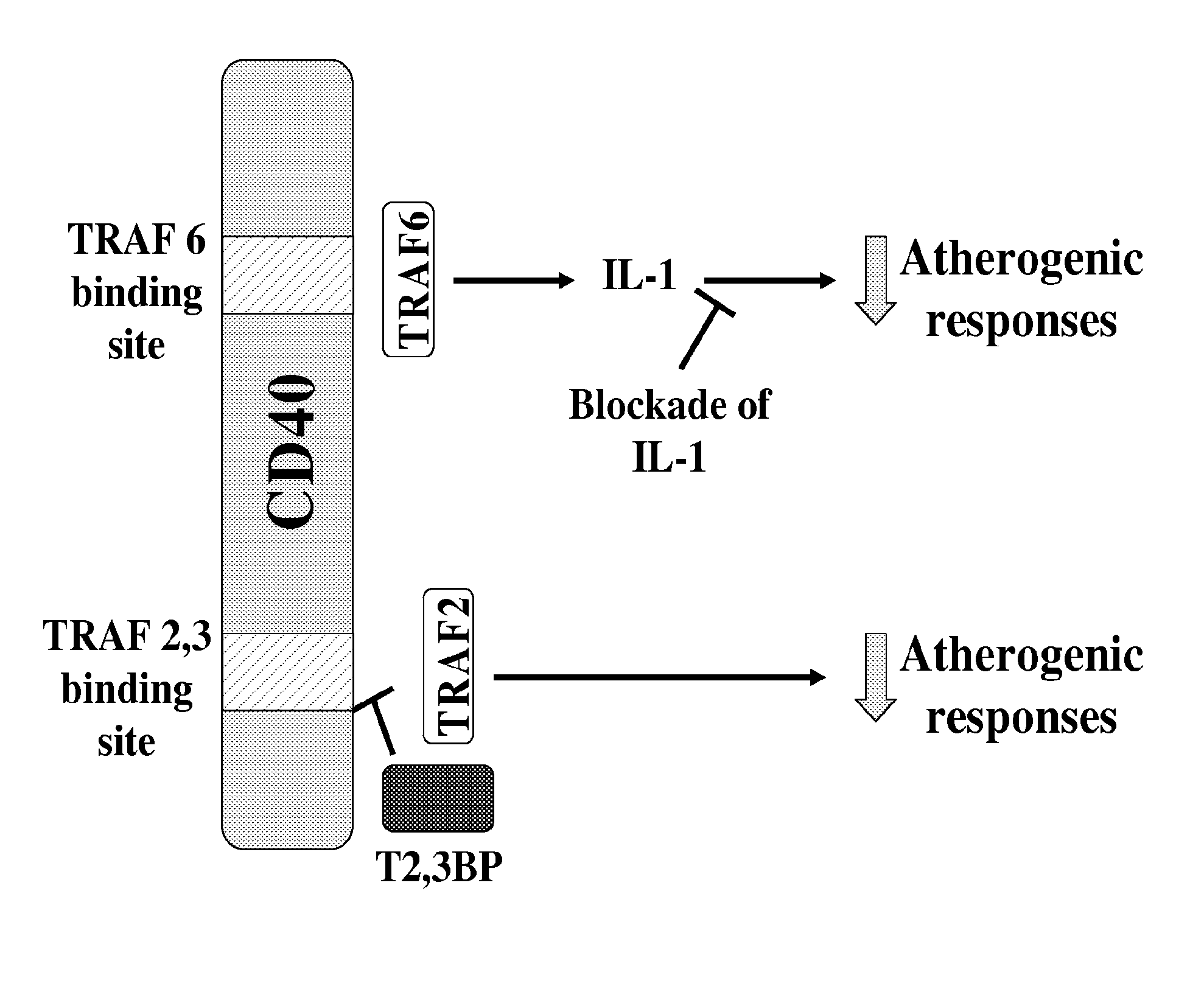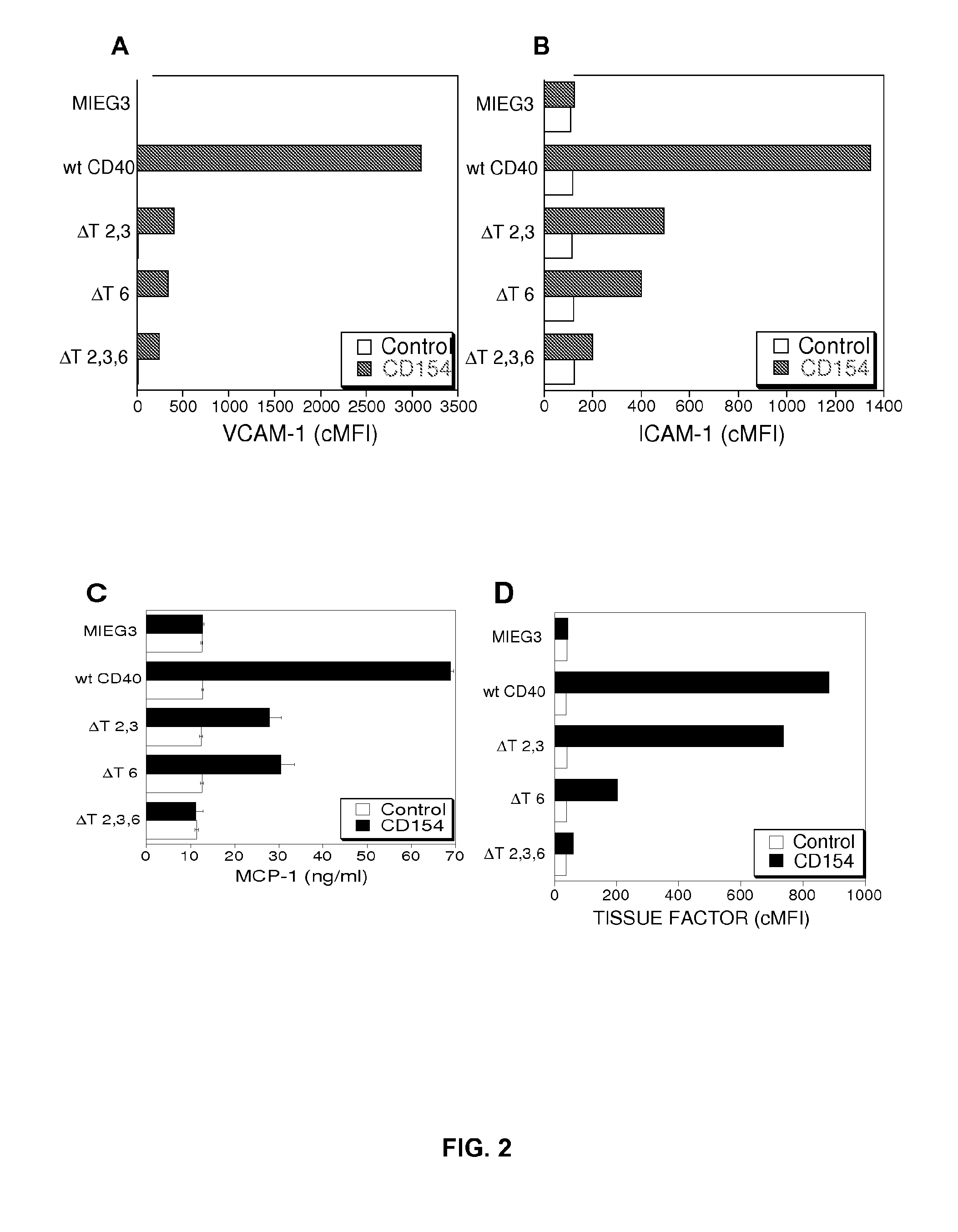Method of treating cd40-mediated diseases
- Summary
- Abstract
- Description
- Claims
- Application Information
AI Technical Summary
Benefits of technology
Problems solved by technology
Method used
Image
Examples
example 1
[0102]Atherosclerosis is an inflammatory disorder triggered by injury to the vasculature. Migration of monocytes (Mo) / macrophages (Mφ) and T cells to the vessel wall is dependent on adhesion molecules and chemokine production. Secretion of pro-inflammatory cytokines and chemokines causes proliferation and migration of smooth muscle cells (SMC) to the intima. Vascular and inflammatory cells produce metalloproteinases (MMPs) that promote plaque rupture. Moreover, tissue factor is induced causing thrombosis.
[0103]CD40 is a central mediator of atherosclerosis. CD40 is present on endothelial cells, SMC and Mo / Mφ present in the atheroma. Its counter-receptor, CD514 is expressed in atheromas by CD4+ T cells. Activated platelets also express CD154. The CD40-CD154 pathway is also involved in re-stenosis after angioplasty or stent placement since levels of soluble CD154 are independent predictors of re-stenosis.
[0104]CD40 is an attractive target for control of atherosclerosis because: i) CD40...
example 2
The TRAF2,3 Binding Site Controls CD40-Induced VCAM-1 and ICAM-1 Upregulation and MCP-1 Production by Endothelial Cells
[0113]CD40 activates a variety of signaling cascades. We explored if CD40 acts through TRAFs to induce pro-atherogenic responses. Human aortic endothelial cells (HAEC) were transduced with retroviral vectors that encode either wild type (wt) CD40 or CD40 with mutations at the TRAF2,3 binding site (ΔT2,3), the TRAF6 binding site (ΔT6) or the TRAF2,3 and TRAF6 binding sites (ΔT2,3,6). These mutations block recruitment of appropriate TRAFs to CD40. The retroviral vector (MIEG3) encodes EGFP enabling identification of transduced cells. In contrast to HAEC transduced with the empty vector (MIEG3), those transduced with wt CD40 or CD40 mutants expressed CD40 and levels of expression of this protein were similar among all groups (p=0.5; n=4). Incubation with CD154 (CD40 ligand) upregulated VCAM-1 and ICAM-1 in HAEC that expressed wt CD40. (FIG. 2A-B). This response is TRAF...
example 3
[0120]Using a model of ischemia / reperfusion (I / R)-induced retinopathy, we examined whether CD40 is an upstream regulator of retinal inflammation and neurovascular degeneration.
Materials and Methods
Animals
[0121]Male C57BL / 6 (B6), CD40− / − (B6 background), and C57BL / 6-TgN(ACTbEGFP)1Osb (B6 EGFP, in which EGFP is enhanced green fluorescent protein; mice were bred at the Animal Resource Center (Case Western Reserve University, Cleveland, Ohio). B6 EGFP mice express EGFP under the control of chicken β-actin promoter (Okabe, M., M. Ikawa, K. Komitnami, T. Nakanishi, and Y. Nishimune. 1997. “Green mice” as a source of ubiquitous green cells. FEBS Lett. 407: 313-319). All animals were originally obtained from The Jackson Laboratory Animals weighed 25-30 g when used for experiments.
Model of Retinal I / R
[0122]Retinal ischemia was induced as we previously described (Zheng, L., B. Gong, D. A. Hatala, and T. S. Kern. 2007. Retinal ischemia and reperfusion causes capillary degeneration: similaritie...
PUM
| Property | Measurement | Unit |
|---|---|---|
| Permeability | aaaaa | aaaaa |
| Immunogenicity | aaaaa | aaaaa |
| Aggregation | aaaaa | aaaaa |
Abstract
Description
Claims
Application Information
 Login to View More
Login to View More - R&D
- Intellectual Property
- Life Sciences
- Materials
- Tech Scout
- Unparalleled Data Quality
- Higher Quality Content
- 60% Fewer Hallucinations
Browse by: Latest US Patents, China's latest patents, Technical Efficacy Thesaurus, Application Domain, Technology Topic, Popular Technical Reports.
© 2025 PatSnap. All rights reserved.Legal|Privacy policy|Modern Slavery Act Transparency Statement|Sitemap|About US| Contact US: help@patsnap.com



